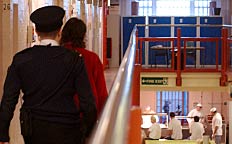Scottish Prison Service
Sentence Planning

Temporary Release

Temporary Release is the generic name for any period of agreed leave (for the prisoner) from prison during their sentence. Temporary leave can be broken down into two basic types: escorted and unescorted leave. Escorted leave means that the prisoner is accompanied by prison based staff to the leave address (and back) for the duration of the visit. Unescorted leave means that the prisoner travels independently to the leave address and back. In most cases, prisoners tend to progress through periods of escorted leave to unescorted leave, though there are exceptions to this rule.
Temporary release presently comes in many forms: home leave being one such type. The Prisons and Young Offenders Institutions (Scotland) Rules 2006 define the specific rules for the various types of leave, with the SPS describing certain criteria. The Prison Rules can be found on the following website: www.uk-legislation.hmso.gov.uk/
The principal purposes of temporary leave may be grouped under three main headings:
- To assist in the prisoner's preparation for release;
- To maintain contact with family members; and
- To "test" or assess the prisoner's ability to copeoutside the prison environment.
The eligibility criteria for the different types of temporary leave are quite elaborate. In essence, eligibility is concerned with all of the following:
- The prisoner's security categorisation — prisoners seeking to be granted leave must have attained a Low Security Supervision Level and have held this for at least three months;
- The length of sentence being served;
- The amount of time the prisoner has spent in custody — Determinate sentence prisoners must have served at least one third of their sentence. Indeterminate sentence prisoners must have no more than four years to serve before the expiry of their "punishment part"; and
- The prison in which the individual is being held — prisoners must have progressed through their sentence and be in either a national Top End[1] facility or in Open Conditions[2] . Moreover, they must have resided in these for a minimum of eight weeks.
The Governor of the prison in which the prisoner is being held makes decisions about temporary release, based on their view of the progress made by the prisoner and level of risk involved. With the development of the Integrated Case Management process, case conferences will begin to link prisoner progression from closed to top end and open conditions prior to the prisoner becoming eligible for temporary release. The case conference will consider this in the light of areas of identified risk and interventions or actions required to minimise risk.
Information provided by the supervising officer about the situation at the home leave address is an important element of this decision and is a requirement of prison rules. The Home Background Report prepared by community based social work will cover, amongst other things:
- Information about the proposed accommodation
- Information about those residing at the address, including the nature and quality of relationship with the prisoner
- Information regarding the attitudes of the victim or of the local community to the prisoner
- Information from departmental records and ICM
- An assessment of the risks (of reoffending and harm) that the prisoner could pose if released temporarily on leave
- Conclusion and recommendation
- In cases of consideration for escorted leave, the report should provide information regarding any significant factors which may influence the family's attitude towards the prisoner or his escort in order to minimise any risk
- Where Schedule 1 prisoners are considered for temporary release the requirements of Circular 18/2003 must be followed to ensure the protection of children who may be at risk
Where a prisoner will be subject to statutory supervision on release is granted home leave, the supervising officer should consider making contact with the prisoner in the community during his home leave.
[1]'Top End' is defined in the Prison Rules as meaning "that part of a closed prison which the Governor has designated as a part of the prison to which there may be allocated prisoners who are considered to be given a range of privileges and who would be eligible to be considered for special escorted leave". The five penal establishments with Top End facilities. These are: (a) Pentland Hall in Edinburgh Prison, (b) Chrisswell Hall in Greenock Prison, (c) The Top End of F Hall in Perth Prison, (d) Peebles House and the Independent Living Units at Cornton Vale Prison, and (e) The Top End Hall in Peterhead Prison
[2]'Open Prison' means any prison which is designated exclusively for the confinement of prisoners who are assigned low supervision level and who are eligible for temporary release in terms of Part 15 (Temporary Release) of the Rules. This applies to: (a) HMP Castle Huntly and Noranside, (b) HMP Inverness 'D' Wing, (c) HMYOI Polmont Beechwood and Iona Halls, (d) HMP Cornton Vale Peebles House, Skye House and the Independent Living Units, (e) HMP Perth Friarton Hall and (f) in the case of a Life prisoner only; to every other prison or part of a prison that is not specified at sub-paragraphs (a) to (e) if there are special circumstances that support the grant of short leave or winter and summer leave. Schedule 1 of the Criminal Procedure (Scotland) Act 1995.